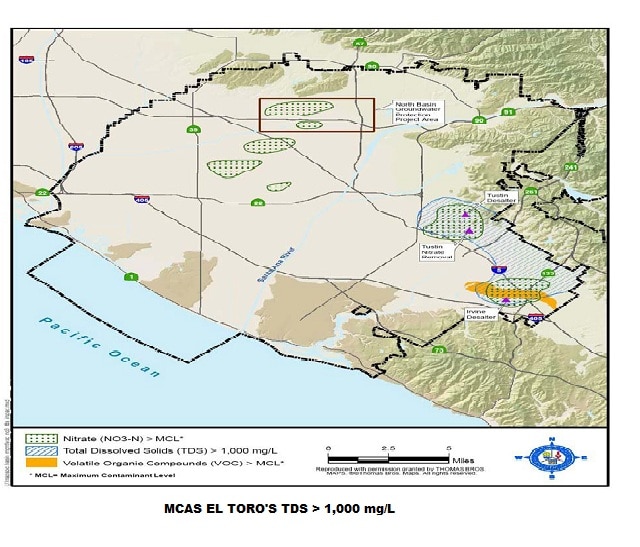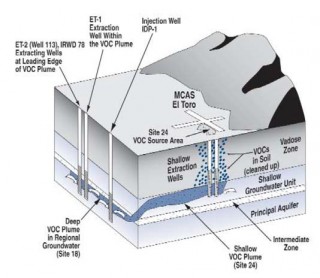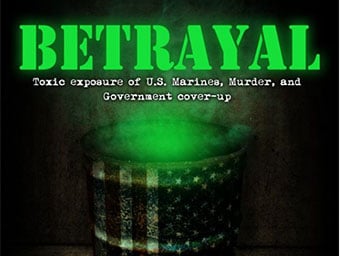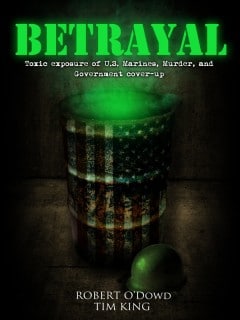Navy wells sealed in concrete after inspection found well screen open in contaminated aquifer
by Robert O’Dowd
(IRVINE, CA) – I don’t believe in ghosts. If I ran into one, maybe I’d change my mind. The stories of lights on in the El Toro control tower after the power was cut off decades ago may be just be the product of someone’s wild imagination. At night, the former base takes on the appearance of a ghost town. With the power to buildings cut off and hundreds of dilapidated buildings still standing, moonlight can play tricks on your mind. Shadows move or seem to move and it doesn’t take too long before normally rational people see things that are not there. The one thing I know for sure is that the risk of exposure to ingestion of toxic chemicals from the base wells was real; too real for those on the base who drank, showered, and cleaned with the well water.
Trichloroethylene (TCE) has an excellent reputation as a degreaser. TCE is a human carcinogen and a non-carcinogenic health hazard. Exposure to TCE can occur through ingestion (contaminated water), inhalation (hot showers, vapor intrusion in buildings), and dermal contact.
El Toro kept no records of TCE usage but based on the TCE plume spreading miles into Orange County’s aquifer, a ‘huge volume’ of TCE was used at El Toro over many decades. TCE waste found its way into the soil, groundwater and the SGU and eventually off-base into the Orange County aquifer. El Toro’s plume cut a path right through the base wells. EPA reported the TCE plume averaged 50 ug/L to 500 ug/L or 10 to 100 times the Maximum Contaminant Level of 5 ug/L above the base wells. Ingestion of contaminated water and inhalation of contaminants during hot showers would affect just about everyone on the base. Well screens opened in El Toro’s SGU would have allowed TCE into the drinking water.
Some things that you can’t see can kill you and the contaminants in SGU were deadly, even if you couldn’t see them. The list of contaminants is long and definitely not anything that anyone would want to be exposed to. They include TCE, PCE, TCA, vinyl chloride, benzene, and carbon tetrachloride. This is not a ‘cocktail’ anyone would voluntarily drink.
The Navy denies El Toro’s base wells were contaminated with toxic chemicals and that municipal water was the only sources of potable water from mid-1951. However, the evidence supports contamination of several wells, a high risk that the wells were contaminated with toxic chemicals from well screens opened in the Shallow Groundwater Unit (SGU); the early purchase of softened municipal water (1951) was not enough to meet the requirements for water for both El Toro and the nearby Santa Ana Air Facility; the 30 years of missing water distribution engineering drawings (1955-1985) and missing original well construction drawings support a government cover-up of well water contamination.
At El Toro, a major TCE plume cut its path right through the base wells. In 1998, a Navy inspection that found one Navy Well No. 4’s screen interval—the first point that water and contaminants enter a well—opened in the SGU. Without the original well construction drawing, the only way to determine the locations of the critical well screen intervals was to inspect each well. Instead, the Navy sealed all of the remaining wells without inspecting them for their wells screen intervals. The dates when the wells were abandoned are unknown; only two complete sets of water distribution drawings are in existence—the original set from 1942 and the latest set from 1986. All the base wells are sealed in concrete and are now like dead men who tell no tales.
NAVY DISPUTES WATER CONTAMINATION
The Navy had no explanation for the purchase of municipal water but published a FACT SHEET in 2008 stating that the base wells and their wells screens drew water from the uncontaminated aquifer. The Navy’s story just doesn’t square with the facts. Why purchase municipal water, if there’s no concern about the well water? In 1998, a Navy consultant confirmed that a physical inspection showed 40 feet of a well screen opened in the contaminated SGU.
The well screen intervals are shown on the original well construction drawings (permanent records) but all of these drawings are missing so only a physical inspection of the wells could determine the locations of the well screen intervals. Water and contaminants enter a well through its well screen. It’s reasonable to assume that other base wells, all build about the same time during WWII, followed the same construction pattern with vertical slots hand cut by torch as well screens, opened in the contaminated SGU. It’s also reasonable to assume that the Navy believed they had too much hard water from elevated Total Dissolved Solids (TDS) causing service disruptions and expensive repairs from corrosive effects of salts in the TDS. In fact, El Toro’s pumping records show several wells out of service for repairs over for months. Although the contract files for municipal water services with Metropolitan Water District (1951-1969) were destroyed years ago, the justification for this negotiated procurement may have been the purchase of softened municipal water would help reduce corrosion in the water from high levels of TDS, allowing the base wells to remain in production for many years.
Like Camp Lejeune on the East Coast, El Toro probably did not test for TCE in the water until another agency notified them of contamination. At El Toro, the Orange County Water District found TCE contamination in agricultural wells off and on the base and looked to the Marines as the source of the contamination. El Toro disagreed that they were the source of the TCE contaminated agricultural wells and the fight went on for years until a settlement was agreed to by the Navy.
The Navy’s story is that El Toro walked away from its base wells in 1951, after the purchase of softened municipal water from MWD. However, the records show there wasn’t enough municipal water from the MWD purchase to abandon the base wells. In February 1951, the Navy contracted with MWD to provide 1 cubic foot per second of softened water or about 450 gallons per minute (448.8 gallons/minute) for both MCAS El Toro and the Santa Ana Air Facility.[1] Delivery began on June 4, 1951.[2]
El Toro’s pumping records showed that the MWD contract didn’t provide enough water to meet the demand for water from both bases. The pumping records from El Toro wells from July to December 1950 showed a total production of 165,432,700 gallons of water, which equates to a combined flow of about 624 gallons per minute from four base wells, significantly more than the contracted for delivery of 450 gallons per minute for both bases and less than the maximum combined output from the four El Toro wells of 900 gallons per minute. [3]
Water is a scarce commodity in Southern California and the decision to purchase municipal water for both El Toro and the nearby Santa Ana Air Facility when there was no known shortage of water in the aquifer and the base wells were less than 10 years old doesn’t make sense unless there was a need to improve the quality of drinking water.
There are no health risks from drinking hard water, but with TDS levels greater than 1,000 ug/L in the SGU, El Toro’s water distribution system would have experienced service disruptions and expensive repairs with well screens opened in the SGU. In fact, El Toro’s pumping records show Wells No. 4, 5 and 6 out of service for repairs for months. The purchase of softened municipal water could have been justified as the most economical way to maintain the base wells and avoid their early abandonment.
El Toro’s SGU was contaminated with TDS from agricultural practices going back to the early 1900s. The Navy’s position is that El Toro’s wells went deep into the Principal Aquifer (PA) like other Orange County wells and were protected by a thick clay barrier from SGU contamination. The assumption is that the well screens drew water from the PA only. But, a Navy inspection of one well before it was sealed in concrete in 1998 revealed that the well screen started in the SGU. All of the wells were constructed in WW II and may have followed a similar construction pattern. The original well construction drawings would show the locations of all well screen intervals. El Toro’s Public Works Department was responsible for the maintaining these records. The records are lost and the Navy was unable to find them.
THE GOVERNMENT’S OPTIONS
With high levels of corrosive TDS in the well water, the Navy had at least three options in 1951: (1) abandon the base wells that were less than 10 years old and construct new wells with their wells screens intervals in the uncontaminated Principal Aquifer (PA); (2) purchase municipal water and abandon all of the base wells and (3) purchase a quantity of softened municipal water to blend with the hard water from the base wells and thereby reduce the corrosive effects of TDS on the water distribution system. The situation was complicated by the Irvine Company’s use of base wells to irrigate its agricultural fields surrounding the base. Irvine had a perpetual lease to Well No. 55 (from 1949) on the base, and no doubt could have had access to other Navy wells, if necessary. Even though the base wells were in the footprint of the TCE plume, there were no tests for TCE in the 1950s and no reason for the government to just walk away from productive wells when the only discernible problem was hard water from elevated TDS levels. Despite the Navy’s objections, there’s support that El Toro’s base wells continued in production long after the municipal water purchase.
I can only speculate on why the other base wells were not inspected for the locations of their well screen intervals. One possibility is that reports of wells screens opened in the contaminated aquifer would have provided ‘grist’ to lawyers for tort suits from dependents and civilian workers injured from toxic exposure. By law, Marines can’t sue the government for injuries on active duty, but that restriction does not apply to their dependents and civilian workers. Without evidence of exposure to TCE and other contaminants, El Toro Marines who later developed cancers associated with exposure to toxic chemicals would have no basis for filing VA disability claims. Unable to sue the government (Feres Doctrine) and without evidence to support a VA disability claim, these Marines would be left to their own resources. For those who served honorably, this is unconscionable.
NAVY SPINS FACTS
The Navy August 2008 Fact Sheet, did an excellent job of spin in describing the water supply and the protective geologic features preventing contaminants from El Toro’s SGU from entering the base’s water distribution system.
The Fact Sheet indicated that an Intermediate Zone of clay 70 to 140 foot-thick prevents vertical movement of water and contaminants from the SGU. Sounds good but the Navy left out the fact that their consulting engineer reported TCE from a water sample in excess of the EPA Maximum Contaminant Level in one well that had more than 40 feet of its well screen open in the contaminated SGU, no follow-up Navy inspections to locate the well screen intervals for the other Navy wells before sealing them in concrete, all of the original well construction drawings lost, and a major TCE plume cutting a path right through the base wells.
The Fact Sheet emphasized the depths of the Navy’s six wells from 440 feet to 645 feet bgs and the thick layer of clay as if this protected the wells from contamination. The depth of the wells was not protective or the layer of clay between the two aquifers, if the well screens were opened in the contaminated SGU. As early as April 1998, the Navy knew there was a risk of contamination from well screens opened in the SGU and with all of the original well construction drawing missing (well screen locations are shown on original well construction drawing); only a physical inspection of every well could confirm the locations of the well screens. The Navy’s emphasis on the depth of wells and nothing about the locations of the well screen intervals is disingenuous at best.
The Fact Sheet didn’t mention that samples taken from one well prior to its destruction in December 2007 found very high levels of petroleum product in the well possibly from leakage from a nearby UST (Underground Storage Tank). Well water contamination from fuel is a risk at any military airfield. Over time, UST can leak. One ‘water sample’ consisted primarily of motor oil at a concentration of 1,200,000 milligrams per kilogram (mg/kg) and a second sample found motor oil at a concentration of 1,600,000 mg/kg as well as methylene chloride, naphthalene, TCE, and 1,2,4-trimethylbenzene at estimated values.
The Fact Sheet did not mention the observations of a Navy BRAC West representative on site to observe well destruction activities in December 2007 who noted that Well No. 2 was constructed “probably in the 1950s or 1960s.” The Navy’s pumping records show that Well No. 2 was constructed during WW II but the Navy representative may have made the right call. As observed by the Navy on-site representative, the well may have been rehabilitated in the 1950s or 1960s to telescope down in size. The Navy representative estimated 9.36 cubic yards was needed to seal the telescoped well. His call was right on target: 9 cubic yard of concrete sealed the well.
The Fact Sheet didn’t mention that Navy Well No. 1 was formerly an agricultural well owned by the Irvine Co. as Well No. 57 prior to the WW II. This well may have been constructed like Irvine Company Well No. 55. TCE was found during an OCWD inspection of Well No. 55 in 1985.
The Fact Sheet noted the early purchase of municipal water from the Metropolitan Water District (MWD) in 1951 and lack of pumping records after December 1950. The implication was that the base wells were not needed when municipal water was purchased from MWD. The Navy didn’t report that approximately 450 gallons per minute of softened municipal water was purchased from MWD for both El Toro and the Santa Ana Air Facility, a quantity exactly half of the combined maximum output of El Toro’s wells in 1949, an insufficient amount to meet the water demands of El Toro and the nearby Santa Ana Air Facility.
The Fact Sheet stated that the maximum combined output was from six Navy wells in August 1945. However, the Navy’s records show that only four wells were ever in production. Well No. 4 was not in production in August 1945 or in 1949 and Navy Well No. 3 was a dry hole. El Toro four wells were good producers as evidenced by their combined maximum output of 900 gallons per minute.
The Fact Sheet failed to mention that all of the Navy wells were in the footprint of the TCE plume and that TCE in this part of the SGU ranged from 50 ug/L to over 500 ug/L or 10 to over 100 times the EPA acceptable level of 5 ug/L.
The Fact Sheet implied that El Toro’s wells were abandoned with the purchase of municipal water from MWD in 1951. El Toro’s water distribution drawings in 1954 showed the Navy base wells as part of the water distribution system. None were marked “abandoned.” A later El Toro drawing from 1975 showed a 10 inch main secured to wells. Portions of the 1975 drawing were redacted; there’s no reasonable explanation for redacting an unclassified engineering drawing.
The Fact Sheet didn’t mention that water distribution engineering drawings are missing for 30 years (1955 to 1985). The latest El Toro water distribution drawing from 1986 showed only Irvine Company Well No. 55. All the Navy wells were abandoned before 1986. The question is when? The Navy’s position is the early purchase of municipal water [softened water] from the Metropolitan Water Districts (MWD) in 1951 and the absence of pumping records from the Navy wells after December 1950 support the wells were abandoned by 1950 or not long after. The problem is the facts don’t support the Navy’s position.
The Fact Sheet didn’t report that the early MWD municipal water contract provided for the delivery of a small quantity of softened water, not enough to meet the demand requirements for both MCAS El Toro and the Santa Ana Air Facility. It’s reasonable to conclude that this contract was intended to reduce the level of hardened water (from the total dissolved solids) by blending softened municipal water with well water. Economically this makes sense. High levels of TDS are corrosive on water supply pipes, pumps and the water distribution system. Reduce the levels of TDS in the system by blending the well water with softened municipal water would allow the base to continue to draw free water from the wells, prolong the useful life of the base wells and reduce the costs of maintenance from hardened well water.
The Fact Sheet did not report that Navy found one well screen open in the contaminated SGU, TCE above the EPA’s MCL in a water sample, and the decision to seal all the remaining wells without knowing the location of their wells screen intervals.
For the enfolding story on the environmental contamination at El Toro and Camp Lejeune, see BETRAYAL: Toxic Exposure of U.S. Marines, Murder and Government Cover-up. This eBook is available from Amazon .com.
[1] Calculations showed that 1 cubic foot per second: One cubic foot of water equals 7.4805 US gallons. Multiplying 7.4805 gallons x 60 seconds equals 448.83 or approximately 450 gallons per minute.
[2] Metropolitan Water District contract 1951: The Navy provided one page from the MWD Annual Report for 1951, which reported that MWD contracted to supply 1 cubic foot of softened water to El Toro and Santa Ana Air Facility.
[3] Flow from these same wells from July to December 1950 was 624 gallons per minute: The average gallons per minute for 4 wells from July 1950 through December 1950 were determined as follows: 165,432,700 gallons/184 days/24 hours/60 minutes = 624 gallons per minute.
[4] Navy Well No. 4 Destruction Report.

Robert O’Dowd served in the 1st, 3rd and 4th Marine Aircraft Wings during 52 months of active duty in the 1960s. While at MCAS El Toro for two years, O’Dowd worked and slept in a Radium 226 contaminated work space in Hangar 296 in MWSG-37, the most industrialized and contaminated acreage on the base.
Robert is a two time cancer survivor and disabled veteran. Robert graduated from Temple University in 1973 with a bachelor’s of business administration, majoring in accounting, and worked with a number of federal agencies, including the EPA Office of Inspector General and the Defense Logistics Agency.
After retiring from the Department of Defense, he teamed up with Tim King of Salem-News.com to write about the environmental contamination at two Marine Corps bases (MCAS El Toro and MCB Camp Lejeune), the use of El Toro to ship weapons to the Contras and cocaine into the US on CIA proprietary aircraft, and the murder of Marine Colonel James E. Sabow and others who were a threat to blow the whistle on the illegal narcotrafficking activity. O’Dowd and King co-authored BETRAYAL: Toxic Exposure of U.S. Marines, Murder and Government Cover-Up. The book is available as a soft cover copy and eBook from Amazon.com. See: http://www.amazon.com/Betrayal-Exposure-Marines-Government-Cover-Up/dp/1502340003.
ATTENTION READERS
We See The World From All Sides and Want YOU To Be Fully InformedIn fact, intentional disinformation is a disgraceful scourge in media today. So to assuage any possible errant incorrect information posted herein, we strongly encourage you to seek corroboration from other non-VT sources before forming an educated opinion.
About VT - Policies & Disclosures - Comment Policy





